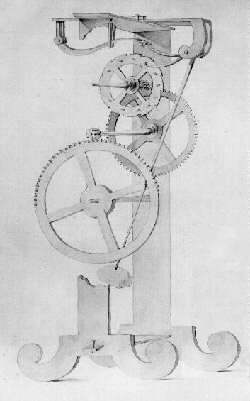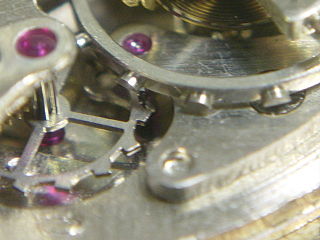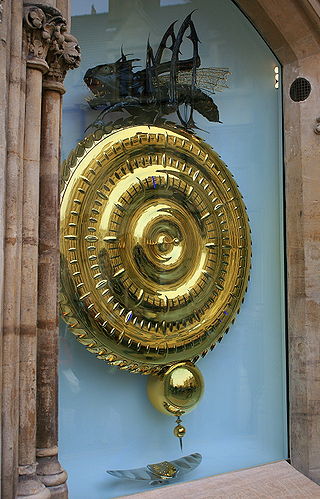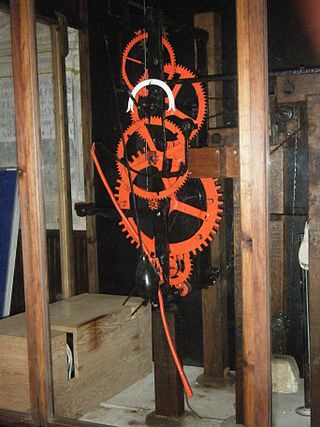
John Harrison was an English carpenter and clockmaker who invented the marine chronometer, a long-sought-after device for solving the problem of calculating longitude while at sea.

A pendulum clock is a clock that uses a pendulum, a swinging weight, as its timekeeping element. The advantage of a pendulum for timekeeping is that it is an approximate harmonic oscillator: It swings back and forth in a precise time interval dependent on its length, and resists swinging at other rates. From its invention in 1656 by Christiaan Huygens, inspired by Galileo Galilei, until the 1930s, the pendulum clock was the world's most precise timekeeper, accounting for its widespread use. Throughout the 18th and 19th centuries, pendulum clocks in homes, factories, offices, and railroad stations served as primary time standards for scheduling daily life, work shifts, and public transportation. Their greater accuracy allowed for the faster pace of life which was necessary for the Industrial Revolution. The home pendulum clock was replaced by less-expensive synchronous electric clocks in the 1930s and '40s. Pendulum clocks are now kept mostly for their decorative and antique value.

A pendulum is a weight suspended from a pivot so that it can swing freely. When a pendulum is displaced sideways from its resting, equilibrium position, it is subject to a restoring force due to gravity that will accelerate it back toward the equilibrium position. When released, the restoring force acting on the pendulum's mass causes it to oscillate about the equilibrium position, swinging back and forth. The time for one complete cycle, a left swing and a right swing, is called the period. The period depends on the length of the pendulum and also to a slight degree on the amplitude, the width of the pendulum's swing.

An escapement is a mechanical linkage in mechanical watches and clocks that gives impulses to the timekeeping element and periodically releases the gear train to move forward, advancing the clock's hands. The impulse action transfers energy to the clock's timekeeping element to replace the energy lost to friction during its cycle and keep the timekeeper oscillating. The escapement is driven by force from a coiled spring or a suspended weight, transmitted through the timepiece's gear train. Each swing of the pendulum or balance wheel releases a tooth of the escapement's escape wheel, allowing the clock's gear train to advance or "escape" by a fixed amount. This regular periodic advancement moves the clock's hands forward at a steady rate. At the same time, the tooth gives the timekeeping element a push, before another tooth catches on the escapement's pallet, returning the escapement to its "locked" state. The sudden stopping of the escapement's tooth is what generates the characteristic "ticking" sound heard in operating mechanical clocks and watches.
A grandfather clock is a tall, freestanding, weight-driven pendulum clock, with the pendulum held inside the tower or waist of the case. Clocks of this style are commonly 1.8–2.4 metres (6–8 feet) tall with an enclosed pendulum and weights, suspended by either cables or chains, which have to be occasionally calibrated to keep the proper time. The case often features elaborately carved ornamentation on the hood, which surrounds and frames the dial, or clock face.

In horology, a movement, also known as a caliber or calibre, is the mechanism of a watch or timepiece, as opposed to the case, which encloses and protects the movement, and the face, which displays the time. The term originated with mechanical timepieces, whose clockwork movements are made of many moving parts. The movement of a digital watch is more commonly known as a module.

In horology, the anchor escapement is a type of escapement used in pendulum clocks. The escapement is a mechanism in a mechanical clock that maintains the swing of the pendulum by giving it a small push each swing, and allows the clock's wheels to advance a fixed amount with each swing, moving the clock's hands forward. The anchor escapement was so named because one of its principal parts is shaped vaguely like a ship's anchor.

The vergeescapement is the earliest known type of mechanical escapement, the mechanism in a mechanical clock that controls its rate by allowing the gear train to advance at regular intervals or 'ticks'. Verge escapements were used from the late 13th century until the mid 19th century in clocks and pocketwatches. The name verge comes from the Latin virga, meaning stick or rod.

A Roskopf, pin-lever, or pin-pallet escapement is an inexpensive, less accurate version of the lever escapement, used in mechanical alarm clocks, kitchen timers, mantel clocks and, until the 1970s, cheap watches now known as pin lever watches. It was popularized by German watchmaker Georges Frederic Roskopf in its "proletarian watch" from 1867. It was invented by Louis Perron, of Besançon, suggested to Roskopf by Jules Grossmann.

Galileo's escapement is a design for a clock escapement, invented around 1637 by Italian scientist Galileo Galilei (1564–1642). Galileo was one of the leading minds of the Scientific Revolution. He was dubbed the founder of theoretical physics. He is also credited with the invention of the celatone and the geometric and military compass. Galileo's escapement was the earliest design of a pendulum clock. Since Galileo was by then blind, he described the device to his son Vincenzio, who drew a sketch of it. The son began construction of a prototype, but both he and Galileo died before it was completed.

A torsion pendulum clock, more commonly known as an anniversary clock or 400-day clock, is a mechanical clock which keeps time with a mechanism called a torsion pendulum. This is a weighted disk or wheel, often a decorative wheel with three or four chrome balls on ornate spokes, suspended by a thin wire or ribbon called a torsion spring. The torsion pendulum rotates about the vertical axis of the wire, twisting it, instead of swinging like an ordinary pendulum. The force of the twisting torsion spring reverses the direction of rotation, so the torsion pendulum oscillates slowly, clockwise and counterclockwise. The clock's gears apply a pulse of torque to the top of the torsion spring with each rotation to keep the wheel going. The Atmos Clock made by the Swiss company Jaeger-LeCoultre is another style of this clock. The wheel and torsion spring function similarly to a watch's balance wheel and hairspring, as a harmonic oscillator to control the rate of the clock's hands.

The Salisbury Cathedral clock is a large iron-framed tower clock without a dial, in Salisbury Cathedral, England. Thought to date from about 1386, it is a well-preserved example of the earliest type of mechanical clock, called verge and foliot clocks, and is said to be the oldest working clock in the world, although similar claims are made for other clocks. Previously in a bell-tower which was demolished in 1790, the clock was restored to working condition in 1956 and is on display in the North nave aisle of the cathedral, close to the West front.

A master clock is a precision clock that provides timing signals to synchronise slave clocks as part of a clock network. Networks of electric clocks connected by wires to a precision master pendulum clock began to be used in institutions like factories, offices, and schools around 1900. Modern radio clocks are synchronised by radio signals or Internet connections to a worldwide time system called Coordinated Universal Time (UTC), which is governed by primary reference atomic clocks in many countries.
In mechanical horology, a remontoire is a small secondary source of power, a weight or spring, which runs the timekeeping mechanism and is itself periodically rewound by the timepiece's main power source, such as a mainspring. It was used in a few precision clocks and watches to place the source of power closer to the escapement, thereby increasing the accuracy by evening out variations in drive force caused by unevenness of the friction in the geartrain. In spring-driven precision clocks, a gravity remontoire is sometimes used to replace the uneven force delivered by the mainspring running down by the more constant force of gravity acting on a weight. In turret clocks, it serves to separate the large forces needed to drive the hands from the modest forces needed to drive the escapement which keeps the pendulum swinging. A remontoire should not be confused with a maintaining power spring, which is used only to keep the timepiece going while it is being wound.

The Riefler escapement is a mechanical escapement for precision pendulum clocks invented and patented by German instrument maker Sigmund Riefler in 1889. It was used in the astronomical regulator clocks made by his German firm Clemens Riefler from 1890 to 1965, which were perhaps the most accurate all-mechanical pendulum clocks made.

A turret clock or tower clock is a clock designed to be mounted high in the wall of a building, usually in a clock tower, in public buildings such as churches, university buildings, and town halls. As a public amenity to enable the community to tell the time, it has a large face visible from far away, and often a striking mechanism which rings bells upon the hours.

The history of timekeeping devices dates back to when ancient civilizations first observed astronomical bodies as they moved across the sky. Devices and methods for keeping time have gradually improved through a series of new inventions, starting with measuring time by continuous processes, such as the flow of liquid in water clocks, to mechanical clocks, and eventually repetitive, oscillatory processes, such as the swing of pendulums. Oscillating timekeepers are used in all modern timepieces.

The Shortt–Synchronome free pendulum clock is a complex precision electromechanical pendulum clock invented in 1921 by British railway engineer William Hamilton Shortt in collaboration with horologist Frank Hope-Jones, and manufactured by the Synchronome Company, Ltd., of London. They were the most accurate pendulum clocks ever commercially produced, and became the highest standard for timekeeping between the 1920s and the 1940s, after which mechanical clocks were superseded by quartz time standards. They were used worldwide in astronomical observatories, naval observatories, in scientific research, and as a primary standard for national time dissemination services. The Shortt was the first clock to be a more accurate timekeeper than the Earth itself; it was used in 1926 to detect tiny seasonal changes in the Earth's rotation rate. Shortt clocks achieved accuracy of around a second per year, although a recent measurement indicated they were even more accurate. About 100 were produced between 1922 and 1956.


The Castle Combe clock in St. Andrew's Church, Castle Combe, Wiltshire, England was probably made in the late 15th century. It is faceless and strikes a bell in the church tower.
















